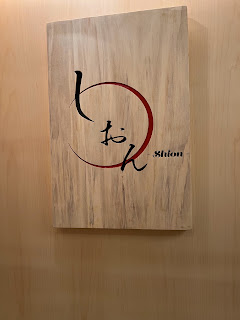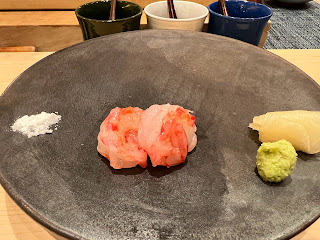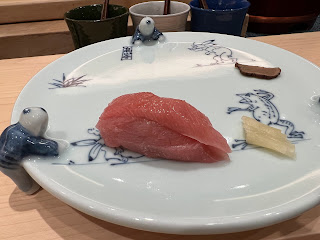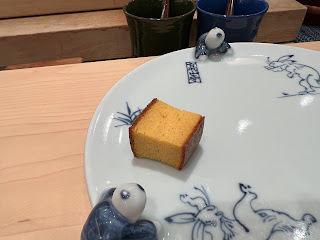This sushi restaurant is located on Wellington Street, headed by Chef Adachi, who used to be with another restaurant in this Central neighborhood.
Quite brightly lit, the restaurant has a simple interior design, without a lot of decoration. There is a nice ambiance though, neat and comfortable, with a spacious L-shaped sushi counter able to accommodate 10 people. We were fortunate to sit right in front of Chef Adachi to witness his skills throughout the dinner.
The Omakase Menu ($2,480 each) started with Tako (章魚) and Mako (鯛の真子). The slow-cooked octopus was very tender, the tentacles fully infused with the flavors of the braising broth. The sea bream roes had a nice bite with a bit of crunchy texture and umami notes.
Next was Kodomo Anago (子供穴子). The baby conger eels were translucent, marinated with a beautiful dashi, finishing with some shiso flowers to increase the fragrance and give a hint of spice. The texture was very good.
Then the chef prepared five different sets of sashimi, with each pairing with its own dipping sauce. The first was Shima-Aji (縞鯵) and Hirame (平目), paired with a light shoyu in order not to mask the milder taste of the fish. The firm texture of the striped jack was nice. Comparatively the thinly sliced flounder had a chewier texture, pleasantly complemented with the sweet sea urchin rolled inside and the fragrant fish oil from the lightly torched engawa on top.
The second set included Kaibashira (貝柱) and Akagai (赤貝), with the chef provided some sea salt for seasoning, in addition to the special sake sauce with finely chopped menegi. The former was the abductor muscle of the scallop, soft with sweet and rich umami taste. The ark shell in contrast had a crunchy texture which matched quite well with the sake sauce.
The third sashimi was Shima-Ebi (縞海老), with the chef cleaning out the prawn and then rolled up, to pair with the special shoyu prepared with its brown meat. The grey prawn had a very sweet taste, with its flavors significantly enhanced by the sauce. Really wonderful.
The fourth sashimi was Katsuo (鰹). After cutting out the slices, the chef went to the kitchen to smoke the skipjack tuna over hay to infuse a nice smoky fragrance. To match with the stronger taste the shoyu provided was also of more intense flavors. This again demonstrated how Chef Adachi thought through the whole experience in details to ensure the best effect.
The fifth sashimi was Saba (鯖) with the skin of the marinated mackerel slightly charred to vitalize the fish oil to enhance the fragrance and flavors, pairing with a special ponzu sauce to give a bit of tart acidity to balance with the fat. It was a great match as it could also reduce the fishy note some people might not prefer for this fish.
Next it was Ankimo (鮟肝). The monkfish liver was creamy and essentially melting in the mouth, with the menegi on top enhancing further the overall flavors. However, I thought it was lacking a bit of the richness of the same dish I had tasted in some other restaurants. Perhaps something to pay attention.
Moving to the sushi part of the dinner. Chef Adachi first removed the vertebral column from the Sayori (針魚), then arranged the two fillets of the Japanese halfbeak beautifully in the shape of an eye. The first time I had witnessed this creative way to prepare the sushi, with a nice bite.
The second piece was something I had never tried before. The Oomizogai (大溝貝), or Dall’s razor clam, was not commonly seen. Its color was a bit more on the greyish side and perhaps not as appealing as some of the other types of clams, but I found it was quite sweet, with a softer texture. Worth to try it out if you happen to come across.
The third piece was a traditional Edomae sushi. Chef Adachi had cut in the middle of a piece of Kohada (小鰭) before inserting another piece to interweave the two to make the sushi. The silvery skin of the marinated gizzard shad was so shiny one could tell immediately its freshness, and it was not overly sour from the marinade. A nice piece.
Then another cooked dish was served. The Hotaru-Ika (蛍烏賊) was plump and sweet in taste, while the Kegani (毛蟹), with the thick sauce, had more delicate flavors. On their own both were nice, but in my opinion if eating the firefly squid first it would overshadow the horsehair crab meat. Perhaps the staff could remind customers the sequence to ensure a better experience.
The next hot dish was another of my favorite in the evening. The Taichio (太刀魚), or largehead hairtail, had been grilled and then dusted with some karasumi to give a nice savory taste, and the soft texture of the fish was truly wonderful. With some seasonal vegetable on the side, it was a must-try.
Returning to the sushi, the chef had taken a lot of work to trim the piece of Toro (鮪), removing the white tendon in the flesh, before cutting into several thin slices and then putting back together to make the sushi. While it did not have the intense flavors like otoro, the soft texture was amazing. A great one.
Before trimming the toro in the last sushi, the chef had also cut some pieces of the lean tuna and put into the soy sauce to marinate for a brief while. The Akami Zuke (本鮪の漬) was flavorful, and perfectly timed to have the shoyu enhancing the umami but not overly salty, with a nice soft texture. Another nice one.
Then it was Awabi (鮑), paired with the liver sauce. Sadly, this was my biggest disappointment on the night, with the abalone a bit too chewy on texture, and the liver sauce too bland and not able to enhance the flavors. I overheard some other customers had shared similar comments.
Moving on it was the seasonal Sakura-Masa (桜鱒) and Shirako (白子). The cherry salmon was very flavorful and soft, while the cod milt creamy and having a nice savory taste. The other highlight was the deep-fried sayori vertebral column, cut out earlier and now turning to be an edible, crunchy snack. With each part on its own wonderfully delicious already, the combination was just amazing.
The chef then took out the Uni (海栗) which had been cured on a piece of kombu to infuse the sea urchin with more umami. Totally dissolving in the mouth, it was quite nice, but I would still prefer the traditional way to have the sea urchin by itself to fully enjoy its original taste.
The last piece of sushi was the Maguro Temaki. The minced tuna roll was another of my favorite, with the chef taking the effort to toast the nori sheet on charcoal to ensure its crispness, before putting on the shari, shiso leaf and minced tuna, and then seasoned. Very delicious with great umami sweetness. After finishing the piece, even for someone of big appetite like myself, would be full.
After checking whether we were full, Chef Adachi provided the piece of home-made Tamago, before also serving the Miso Soup. The egg was decent, and the soup was warming to the stomach, providing us a good sense of comfort and satisfaction.
The dessert was White Strawberry, Melon and Hojicha Pudding. The seasonal fruit was sweet and juicy, and the pudding had good fragrance of the roasted tea, not overly luscious.
The bill on the night was $5,456 and even though it was a bit on the high side, the overall dining experience was nice, with friendly and attentive service, as demonstrated through an example of the renown Japanese style in hospitality: I noticed the chef had re-arranged the ginger and daikon on a customer’s serving plate subtly, after seeing that she is left-handed. While there was not a lot of conversations because of the language barrier, he also explained each of the dish to us in his best effort. For Japanese food-lovers who might not like strong seasoning, this place would be a good choice.
























沒有留言:
張貼留言